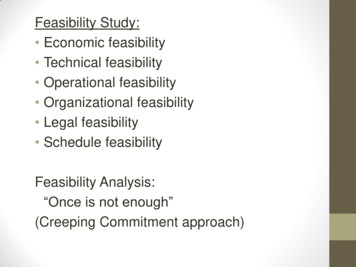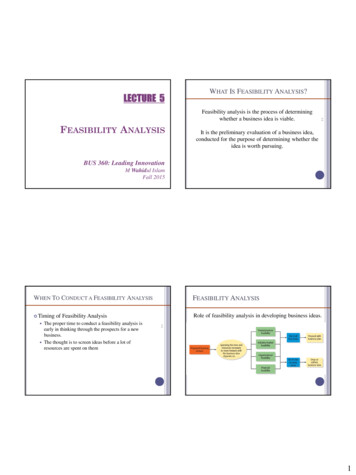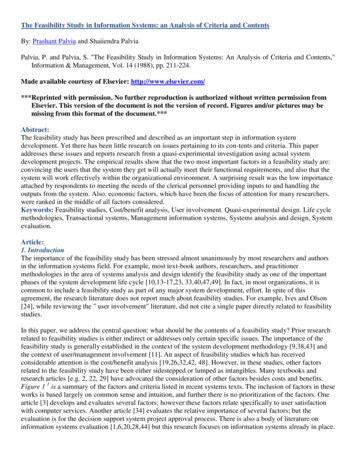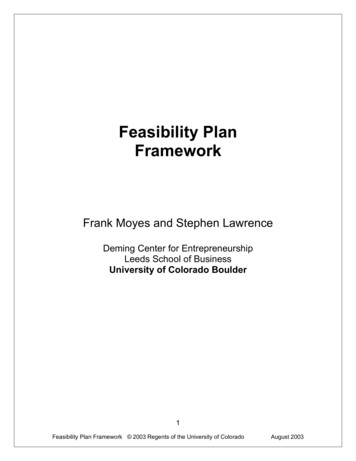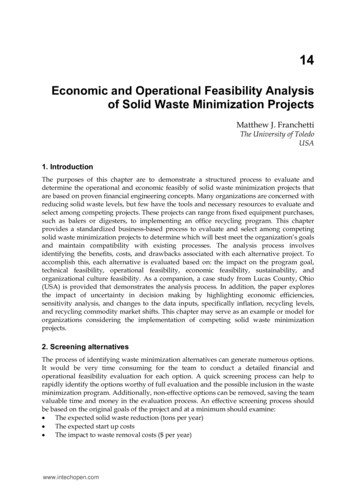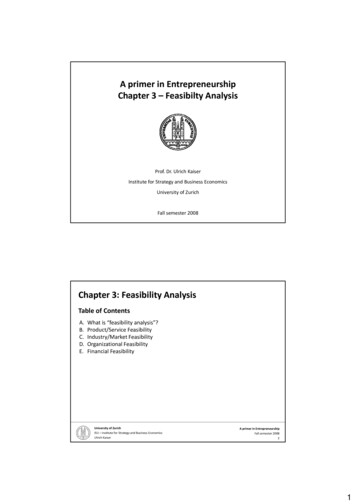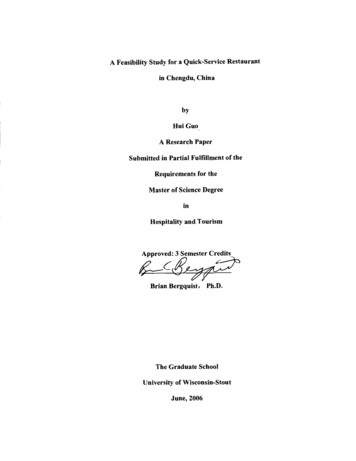
Transcription
A Feasibility Study for a Quick-Service Restaurantin Chengdu, ChinabyHui GuoA Research PaperSubmitted in Partial Fulfillment of theRequirements for theMaster of Science DegreeinHospitality and TourismBrian Bergquist , Ph.D.The Graduate SchoolUniversity of Wisconsin-StoutJune, 2006
The Graduate SchoolUniversity of Wisconsin-StoutMenomonie,WIAuthor: Guo, HuiTitle: A Feasibility Study for a Quick-Service Restaurant in Chengdu, ChinaGraduate Degree/ Major: MS Hospitality and TourismResearch Adviser:Brian Bergquist, Ph.D.MonthNear:June, 2006Number of Pages:59Style Manual Used: American Psychological Association, 5theditionABSTRACTThe purpose of the study is to determine the feasibility of opening a fastfood restaurant selling toufunao in Jingyang living area, Wuhou District in thecity of Chengdu. Toufunao is a local food extremely popular in the city of Leshanin Sichuan Province of China, but toufunao hasn't enjoyed the same popularity asother types of Leshan food have in Chengdu. The study will first look at theliterature with regard to restaurant feasibility study, and then follow the four stepsproposed by the literature to conduct the feasibility study of the proposedrestaurant. Market area, site selection, competition and financial analysis are madethrough observational research, surveys and literature review, and results of theanalysis are concluded.
The Graduate SchoolUniversity of Wisconsin-StoutMenomonie, WIAcknowledgmentsI want to extend my sincere thanks to Dr. Brian Bergquist for his consentto be my thesis advisor, his time and hard work advising on my thesis progressand his valuable suggestions without which I could never complete my thesis. Ialso want to extend my thanks to my husand for his help with conducting surveysand formatting my thesis, and his encouragement when I was not making progresswith my research. Thank my parents for their support for quitting my job in Chinaand furthering education in US.
TABLE OF CONTENTS.ABSTRACT .11List of Tables .viChapter 1 Introduction .1Statement of Problem:.33Research Objectives: .Assumptions of the study:.3Definition ofterms: .4Chapter I1 Literature Review .6Market area .7A . Market area identification.8B. Population profile, and consumer spending pattern of the market area. 1011C. Future development of market area .Site selection analysis .13Competition analysis.1416Pro Forma Financial Statement .Chapter I11 Methodology .18Subject Selection and Description: .18Instrumentation:.1920Data Collection Procedures: .Data analysis .21Limitations .21Chapter IV: Results .22Competition analysis result.22
Site selection result .23Consumer spending pattern and market potential research result.28Financial analysis result.39Chapter V Discussion .41Limitations .4343Recommendations .References .4547Appendix 1: site selection criteria checklist .Appendix 2: site selection criteria checklist.Site No .1.48Appendix 3: site selection criteria checklist.49Site No.2 .Appendix 4: Restaurant Competition Analysis Worksheet .50Appendix 5: Calculation of Lunch and Dinner Revenues per 28 days .5253Appendix 6: Monthly Pro Forma Financial Statement .Appendix 7: Population Spending Behavior and Market Potential Survey .54
List of TablesTable 1 How much do you usually spend on your breakfast? .2929Table 2 How much do you usually spend on your lunch? .Table 3 How much do you usually spend on your supper? .29Table 4 Where do you usually have your breakfast during the work days? .30Table 5 Where do you usually have your lunch during the work days? .30Table 6 Where do you usually have your supper during the work days? .30Tabel 7 How much do you usually pay for Xiaochi? .3132Table 8 How old are you? .Table 9 What is your sexuality? .3233Table 10 Have you heard about Leshan Niuhua toufunao? .Table I I Do you know that there is a difference between Leshan toufimao and Chengdutoufunao? .3334Table 12 Have you ever eaten Leshan Niuhua toufunao? .Table 13 If you haven't eaten Leshan Niuhua toufimao. but there is one selling such typeof food near your home. will you go and try how it is like? .34Table 14 If you have eaten toufunao. how do you like its taste? If you haven't eaten. .toufunao. skip this item.34Table 15 If you have eaten toufunao. what do you think of the price 2 yuanlmiddle bowl?35If you haven't eaten toufimao. skip this item.Table 16 If you have eaten toufunao. how do you like its appearance? If you haven'teaten toufunao. skip this item.35Table 17 Have you eaten niuroubing? .36
Table 18 If you have eaten niuroubing, do you like niuroubing? If you haven't eaten. .niuroubing, please skip this item .36Table 19 If you have eaten niuroubing, how do you think of the price of 2 yuanloneniuroubing? If you haven't eaten niuroubing, please skip this item. .36Table 20 If you have eaten both toufunao and niuroubing, do you think that the37combination will make a meal? .Table 21 If you like toufunao, how many times do you think that you will like to eat perweek? .3738Table 22 Are you from Leshan? .Table 23 If you are from Leshan, do you like doufunao from Leshan? If you are not from38Leshan, please skip this item. .Table 24 If you like toufunao from leshan, and there is such a restaurant selling such atype of food near your home, will you go and eat in the restaurant a lot? If you38don't like toufunao, please skip this item. .
Chapter 1 IntroductionThe paper is to present a proposal for a master's thesis which seeks to conduct afeasibility study for a fast-food restaurant selling toufunao in Jinyang Road, JinyangLiving Area, Wuhou District, Chengdu, the capital city in Sichuan Province.Toufunao is a famous food in Leshan, a town with 200,000 people located 130 krnSouth to Chengdu, the capital city of Sichuan Province with 4, 170,000 people. It is a hotand spicy soup made out of toufu, starch, rice noodles, fried soybeans and varieties ofseasoning, and it is usually eaten with niuroubing, which is like a beef sandwich. Thecombination of beef, bread, toufu, starch, rice noodles and varieties of seasoningsprovides balanced nutrition containing protein, carbohydrate and calorie. The soup andniuroubing can be prepared in large amount and saved by sitting them on holding pan,thus reducing the serving time to only around 30 seconds. The cost of the food is verylow and is only around 10 cents. 30-second preparing time, balanced nutrition and lowcost makes the food an ideal candidate for fast food.Despite toufunao's popularity in Leshan, it hasn't found its presence in Chengdu,yet. However, food oiginated in Leshan has already gained a good reputation in Chengdu,and Leshan, as a result is considered one of the best cities to go for good food for peoplein Chengdu. Two types of food originated in Leshan, have already been well accepted bypeople in Chengdu. They are boboji and shaokao.Boboji are small pieces of precooked meat and-vegetablesskewered on thinbamboo sticks and then soaked in a specially-made source for hours before serving.Boboji is premade and can be served upon order. When boboji is served, a bobo, aChinese word for a big bowl, contains both the source and the skews of meat and
vegetables, will be brought to the table. Then people will eat meat and vegetables off thebamboo sticks, which makes the eating experience not only a convenient one but alsofull of fun. Boboji didn't enter the Chengdu market until the beginning of this century,and have developed very fast in the market since then. Leshan, as the place where thetype of food originated from, is added to the names of certain boboji places as anindicator of the genuineness of the food and a brand to attract customers. The price ofboboji on Chengdu market is 6.25 cents per skewer, and is mainly sold on a shabby foodstands and served on shabby tables in the open air on the streets. Despite the unpleasanteating environment, people still come in groups of three or four and each groupconsumes several hundred skewers of meat and vegetable.Shaokao are small pieces of uncooked meat and vegetables skewed on bamboosticks, and then grilled on burning charcoal while a variety of spices are added onto themeat and vegetables. Unlike boboji, shaokao is not premade, but fresh meat andvegetables have to be grilled for around 5 minutes before serving. It was introduced tothe city in the 1990s, thus more shaokao places can be seen on the Chengdu market thanboboji. Exactly same as boboji, Leshan is also added to certain shaokao places as anindicator of the genuineness of the food and as a brand to attract customers. The price ofshaokao is also 6.25 cents per skewer, and is also sold on the food stands but usuallywithout tables, since compared with boboji, shaokao is less juicy thus is usually orderedas to-go food and is eaten while people is on their way.Toufunao and shaokao are both considered as xiaochi, meaning food eatenbetween meals. However, toufunao itself and the way it is served decide that it can beeaten both as xiaochi and meals, which means potentially higher market demand.
The proposed study seeks to decide the feasibility of opening a quick-servicerestaurant with only toufunao and niuroubing as its menu in Jinyang Road of WuhouDistrict in Chengdu, the shopping area of Jinyang living areas. The following discussionwill provide the reader with an understanding of the background of the study, thepurpose of this study, reasons why this topic was important and methods selected fordata collection and analysis.Statement of ProblemThe purpose of the study is to determine the feasibility of opening a fast foodrestaurant in Jinyang Road, Wuhou District, Chengdu, China. Data will be collectedthrough observational research method and through a survey distributed to potentialcustomers in Chengdu, China.Research ObjectivesThe following questions will be answered after the completion of the research:1) What area can be identified as the market area of the proposed restaurant?2) What is the customer profile of the market area of the restaurant, such aspopulation size, consumer spending patterns and average household income, etc?3) Who are the competitors of the proposed resturant and how are they doing?4) Which of the chosen locations is the most desirable one based on restaurant siteselection guidelines?5) Will the proposed restaurant be able to gain profit with the proposed pricing,operation hours, the estimated restaurant turn over rate, and estimated controllable anduncontrollable expenses?
Assumptions of the StudyIn view of the successful entry of boboji and shaokao into Chengdu market,established popularity of toufunao in Leshan local market, and the fact that toufunao canbe both xiaochi and regular meals, an assumption can be made that a fast food restaurantspecializing in toufunao and niuroubing and located in jinyang road, Wuhou District,Chengdu, where 60,000 people currently live can be a success as well.Definition of TermsThe following terms are listed and emphasized to give clarity to the reader inreading the research:Accessibility: road capability and adequate ingress and egress of the proposedrestaurant site.Customer profile: information of the customers of the proposed restaurant regardingtheir ages, incomes, occupations, their reasons for visiting the restaurant, and theirfrequency of their visitDemography: the statistical study of people and their characteristics.Enclosed mall: a shopping center entirely inside a roofed structure, so that entranceto the mall is controlled by a limited number of entrances and most stores areaccessible only via interior corridorsDirect competition: the food service facilities that are competing directly with aspecific menu of the proposed restaurantGenerative area: concentrations that attract people and automobile activityIndirect competition: the food service facilities that are not competing directly witha specific menu of the proposed restaurant
Market area: the geographical area from which a business draws its customersSeat turnover rate: The number of times each restaurant seat is occupied bydifferent patrons during a particular meal period.
Chapter I1 Literature ReviewNational Restaurant Association divides a restaurant feasibility study into five steps,which are 1) identifying market area and gathering of demographic data such as age, sex,income, dining-out habits and other characteristics of potential customers 2) conceptdevelopment, which involves using the data about the population in the market area andforming and evaluating a restaurant concept that fits the area's needs and preferences. 3)site analysis, a process to determine whether the characteristic of the site and thecompetitive environment around the restaurant will support such a concept. 4) competitoranalysis, which involves investigating competitors in the market area through acompetitor analysis worksheet. 5) financial analysis, a process of specifying revenuegenerating criteria, computing estimated average-check and revenue figures, estimatingoperating expenses, analyzing and interpreting the financial statement, and finally,developing an implementation plan.(http://www.restaurant.org/m a magArticle.cfm?icleID 294)The chapter willinclude published knowledge that correlates with the five steps excluding step two,because in this study the concept has already be firstly chosen, thus including foursections. The first section will look at literature about how a trade area or market areashould be determined, literature of the demographic characteristics and consumersspending patterns of the market area. The second section will comprise literature aboutcompetition analysis, and the third section will include literature about site-selectionanalysis for a start-up restaurant, and the last section will include literature of financialanalysis.
Market AreaBefore any research can be done, the market area of the proposed business must beidentified to go further in the exploring process. A market area is defined byMelaniphy(1992) as the area from which a unit can expect to capture approximately 85%of its business. (P56).For an established restaurant business, it is not hard to get market area information.Surveys can be made to gather information about where .the customers are from, and plotson the maps can be made to give a clear of picture of the market area or trade area.(Melaniphy, 1992). On the other hand, it is hard to predict the market area of a proposedrestaurant because no information as to where the customers are from is available for afuture restaurant. But this information can be collected by gathering such informationfrom vehicle stickers, license plate, competitors' customer0 interview, mailed-backquestionnaire from competitive facilities. (Melaniphy, 1992)However, in this study, market area can be easily identified since the proposed sitewill be located right across the street of a big enclosed shopping mall and customers ofthe restaurant will be mostly customers of the shopping mall. Thus the market area of thesupermarket will be the same as that of the restaurant. The shopping mall is now stillunder construction and all businesses are scheduled to open on Oct. 1st in 2006, thenational day of China. The following discussion will first identify the market area of theshopping mall and analyze the characteristics of the market area, and then describe thefuture development of the market area of the proposed restaurant.
A. Market Area Identz cationThe site of the three-floor and altogether 50,000 square meters (538,213 square feet)shopping mall is located in Jinyang living area, Wuhou District, Chengdu on the "T"comer of Jinyang Road and Jingji Road in the west of Chengdu. Jingji Road is now stillunder construction and will be completed in May of 2006. Jinyang Road is a six-laneroad extending to the bordering Shuangliu county, and traffic flow of the road is as highas 64 motor vehicles (including cars, taxes and buses) per minute during non-peaktime.(observed at 16:25 Beijing Time on Jan. 20,2006). The four-lane Jingji road to becompleted in May will connect Jinyang Road and Wuhou Road. Wuhou Road extends toWuhou High-Tech West Zone, a state-level high-tech area which host 214 companies.The nearest supermarket for residents in Jinyang living area is twenty-minute bus rideplus bus waiting time ranging from none to half an hour. However, the establishment ofBailian, the shopping mall under construction is located within walking distance of mosthousing projects in the living area and five-minute bus ride of a few housing projects.Thus all housing projects in Jinyang living area can be identified as market area of theshopping mall.Jinyang living area is one living area of Wuhou District, one of five Districts inChengdu. Jinyang livng area was first developed in the year of 1996, when the countryfirst initiated the housing reform policy. The widely called Five Big Gardens, whichrefers to the five housing projects located in the northem part of Jinyang living area,namely Zhongyang Garden, Huangjia Garden, Mingliu Garden, Hongyun Garden, JiadaGarden, are the first group of housing projects built to sell in Chengdu after theimplementation of housing reform in China. Following the first group of housing
projects, four projects were built in the area at the beginning of this century, and they areHaitian Ge, Chuiti Chunxiao, Jiaoda Courtyard, and Huisuo Garden. After September of2004, eleven new housing projects in this area started construction and is now put on themarket, which are Ruitai Jincheng, Yihe Yaju, Xinyuan Jiayuan, Shuirun Tixiang,Jinyang Yingzuo, Jiangyuan Caiting, Lijing Huating, Huaxiang Tingyuan, Zhuyun Tianfu,Xiejia Guitian and Xinling. There are currently 60,000 people living in Jinyang livingarea, but after all of the newly-built housing projects are occupied with residents, the totalliving capacity of this area within a five-minute bus ride to the shopping mall will be100,000 people. (http://www.028028.net shownews.asp?id l69)However, according to Li Kui of Wanda Property Development Company,(http://www. 718.html), ashopping center with an areage of 3000 square meters needs no more than 10,000 people,with an areage from 3,000-10,000 square meters( from 32,293 square feet to 107624square feet) needs 100,000 to 300,000 people, and with an areage of more than 30,000square meters (322,927 square feet) needs no more than 300,000 people. The shoppingmall under construction has an areage of 50,000 square meters (538213 square feet), thusit needs more than 300,000 people. With a total population of 100,000, the market area ofthe shopping mall is not able to support the shopping mall, but it is big enough to supporta fast-food restaurant sitting across the street from the shopping mall on Jinyang Road.Thus, Jinyang living area, which is within 1.5 kilo meters' radius to the proposedrestaurant site, and currently lives around 60,000 people with a potential to grow up to100,000 can be identified as the market area of the restaurant.
B. Population Profile, and Consumer Spending Pattern of the Market AreaAfter determining the market area of the restaurant, the following paragraphs willlook at literature of the demographic profile and consumer spending pattern of marketarea.Demographic profile of the people in the proposed site is essential in determiningwhether or not to open a restaurant in a proposed site. Demographic profile includes thetotal population in the market area, the number of employed persons, working women,income level, population age, housing and family structure. Among all the differentaspects of demographic profile, total population of certain area reveals some informationof the area in question, but it is the population profile, especially income distribution andage distribution, that reveals the information needed by any business person to make theirdecision. As Melaniphy (1992) indicated, "what matters is not the total number but ratherthe characteristics of those people." "A more realistic way of expressing population needsis to determine how many people you should have in the appropriate age and incomecategories." (P116). " In more than 30 years of evaluating and selecting locations, I havefound age and income to be the most sensitive demographic elements in identifying theright opportunities."(P117). It can be found from Melaniphy (1992)'s statements that ageand income distribution reveals the most how much eating-out need there is among theresearched population. Thus, in this case study, the researcher will focus on the two mostimportant aspects of demographic characteristics, age and income distribution and alsodiscuss other related demographic features.According to National Restaurant Association (1998),"in addition to the basicinformation on your potential customers gained through demographic studies, you will
need to know more about their habits of eating away from home." But how to determinetheir eating-out behavior, National Restaurant Association (1 998) provides the followingguidelines based on different types of restaurants and their targeted market segment."a. The average person (8 years and older) eats out 4.1 times a weekb. Singles and married couples with no children eat out more frequently thanfamilies with children."c. As income increases, consumers eat away from home more frequentlyd. People 18 to 24 year old eat out more often than other age groups.e. households with a working female eat out more frequently than those with a nonworking female."Matching up these guidelines with demographic characteristics informationprovides the clue to the consumer spending behavior.In this study, population profile and consumer spending pattern will be collectedmainly through surveys due to the lack of such statistics from the government.C. Future Development of Market AreaDespite the continuing growth of the area, the living infrastructure in Jinyang livingarea is not desirable at all. There are only one primary school, one bank and someindependent front store businesses, but there are no middle schools, kindergartens,hospitals, post offices and shopping center in the area. The ten roads within the livingarea are either bumpy and dusty or dead-end roads. Wuhou District governmentannounced its plan at the end of 2004 to invest one billion yuan (125 million US dollars)into the improvement of living infrastructure in the area, which includes building twomiddle schools, four primary schools, seven kindergartens, one hospital, three public
restrooms, two garbage transferring centers, one post office, and two agricultural productmarket, and building ten more roads and repairing ten old roads within the living area.The investment is supposed to completely change the living condition of the area andmake the living conditions in this area comparable to Shuangnan living area, area livingarea in Wuhou District selected as the best living area in 2004 by Chengdu city dwellers,within three years from 001476641.shtml)The housing price is souring after the government's announcement. When Five BigGarden was just put on market in 1996, the selling price was then around 800 yuan (100dollars) per square meter, but in the year of 2004, the price of the second-handapartments in the area was already 1,600 yuan (200 US dollars) per square meter andapartments of new housing projects are selling at the price of 2,400 yuan (300 USdollars) per square meter. However, compared with Shuangnan living area, the bestselected in 2004 by Chengdu city dweller, the average housing price of Jinyang livingarea was around 1,000 yuan (125 US dollars) per square meter, or 38.5% lower in 2004.The essential reason of the low price rate of the projects is that the living infrastructure ofthis area is not well developed. After the announcement of the government investmentplan, the housing price in Jinyang living area has been increasing at a higher rate than thecity average. In the last month of 2005, the price of new housing projects in this area was3750 yuan (469 US dollars) per square meter, when in Shuangnan it was around 4500yuan ( 562 US dollars). The difference was narrowed down to 750 yuan (94 US dollars)or 17 percent, compared with 1,000 yuan (125 US dollars) and 38.5% in 2004.( http://www.028028.net/shownews.asp?id 169)
The soaring housing price in Jinyang living area, which is identified as the primarymarket area of the shopping mall, the continuing addition of new projects into the livingarea after the end of 2004 when the government announced its investment plan and thepopularity of the new projects among apartment buyers indicate that Jinyang living areais going to attract more residents with middle-to-high income level. This provides anincreasing market demand for xiaochi and fast-food in this area.Site Selection AnalysisAfter all the market area identification, population characteristics and consumerspending pattern, and competition analysis have been made, the next step to be made isto decide which specific place the proposed restaurant should be located, or " identifylocational opportunities within the area delineated." (Melaniphy,1992, P264,) There is awide range of literature concerning site selection, and all the literature agre
The purpose of the study is to determine the feasibility of opening a fast food restaurant in Jinyang Road, Wuhou District, Chengdu, China. Data will be collected through observational research method and through a survey distributed to potential customer
